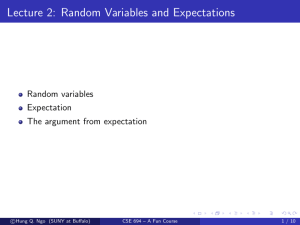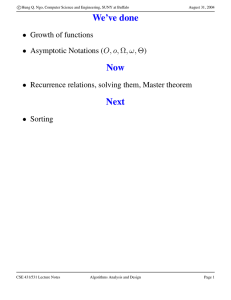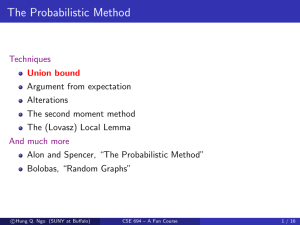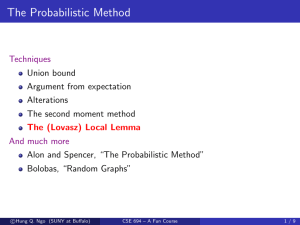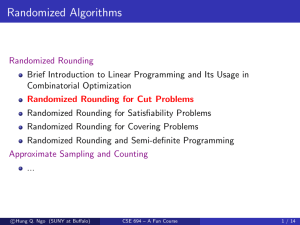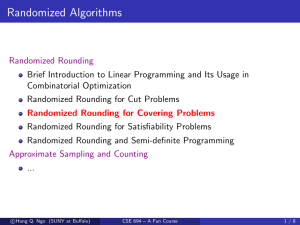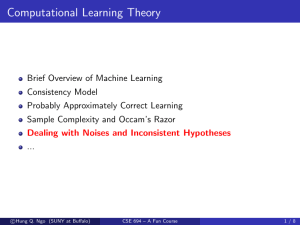The Probabilistic Method
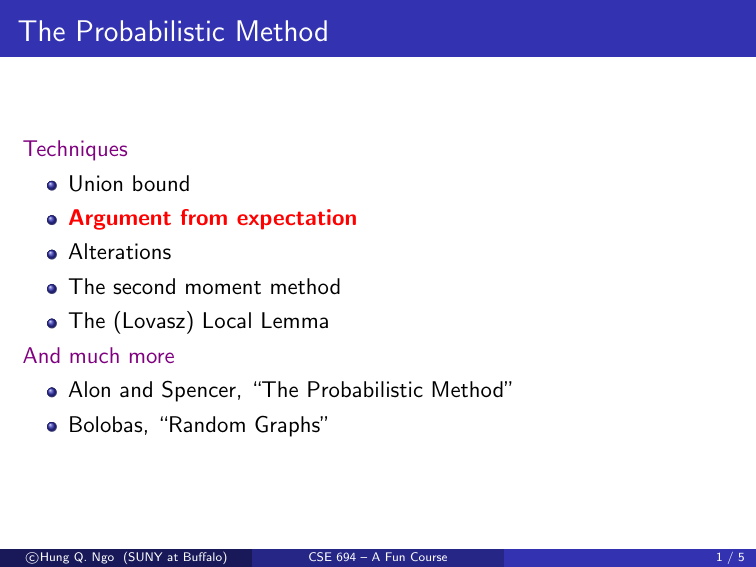
The Probabilistic Method
Techniques
Union bound
Argument from expectation
Alterations
The second moment method
The (Lovasz) Local Lemma
And much more
Alon and Spencer, “The Probabilistic Method”
Bolobas, “Random Graphs” c Hung Q. Ngo (SUNY at Buffalo)
1 / 5
The Argument from Expectation: Main Idea
X a random variable with E [ X ] = µ , then
There must exist a sample point ω with X ( ω ) ≥ µ
There must exist a sample point ω with X ( ω ) ≤ µ
X a random variable with E [ X ] ≤ µ , then
There must exist a sample point ω with X ( ω ) ≤ µ
X a random variable with E [ X ] ≥ µ , then
There must exist a sample point ω with X ( ω ) ≥ µ
Have we seen this?
c Hung Q. Ngo (SUNY at Buffalo)
2 / 5
Example 1: Large Cuts in Graphs
Intuition & Question
Intuition : every graph must have a “sufficiently large” cut ( A, B ) .
Question : How large?
Line of thought
On average, a random cut has size µ , hence there must exist a cut of size
≥ µ .
Put a vertex in either A or B with probability 1 / 2
Expected number of edges X with one end point in each is
E [ X ] = E
"
X
X e e
#
=
X
Prob [ X e
] = | E | / 2 e
Theorem
For every graph G = ( V, E ) , there must be a cut with ≥ | E | / 2 edges c Hung Q. Ngo (SUNY at Buffalo)
Note: this algorithm can be derandomized!
3 / 5
Example 2: ± 1 Linear Combinations of Unit Vectors
Theorem
Let v
1
, · · · , v
There exist α
1 n
, be n unit vectors in
R n
.
· · · , α n
∈ {− 1 , 1 } such that
| α
1 v
1
+ · · · + α n v n
| ≤
√ n and, there exist α
1
, · · · , α n
∈ {− 1 , 1 } such that
| α
1 v
1
+ · · · + α n v n
| ≥
√ n
Simply because on average these combinations have length
√ n
Specifically, choose α i
∈ {− 1 , 1 } independently with prob.
1 / 2
.
E | α
1 v
1
+ · · · + α n v n
|
2
=
X v i
· v j
E [ α i
α j
] =
X v
2 i i,j i
= n.
c Hung Q. Ngo (SUNY at Buffalo)
4 / 5
Example 3: Unbalancing Lights
Theorem
For 1 ≤ i, j ≤ n , we are given a ij
α i
, β j
∈ {− 1 , 1 } such that
∈ {− 1 , 1 } . Then, there exist
X X a ij
α i
β j
≥
r
2
π i j
+ o (1)
!
n
3 / 2
Choose β j
∈ {− 1 , 1 } independently with prob.
1 / 2 .
R i
= P j a ij
β j
, then
E [ | R i
| ] = 2 n n − 1 b ( n − 1) / 2 c
2 n
≈
r
2
π
+ o (1)
!
n
1 / 2
Choose α i with the same sign as R i
, for all i c Hung Q. Ngo (SUNY at Buffalo)
5 / 5
